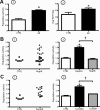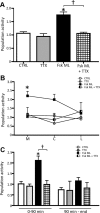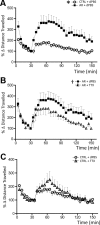Aversive stimuli alter ventral tegmental area dopamine neuron activity via a common action in the ventral hippocampus
- PMID: 21411669
- PMCID: PMC3066094
- DOI: 10.1523/JNEUROSCI.5310-10.2011
Aversive stimuli alter ventral tegmental area dopamine neuron activity via a common action in the ventral hippocampus
Abstract
Stress is a physiological, adaptive response to changes in the environment, but can also lead to pathological alterations, such as relapse in psychiatric disorders and drug abuse. Evidence demonstrates that the dopamine (DA) system plays a role in stress; however, the nature of the effects of sustained stressors on DA neuron physiology has not been adequately addressed. By using a combined electrophysiological, immunohistochemical and behavioral approach, we examined the response of ventral tegmental area DA neurons in rats to acute as well as repeated stressful events using noxious (footshock) and psychological (restraint) stress. We found that aversive stimuli induced a pronounced activation of the DA system both electrophysiologically (population activity; i.e., number of DA neurons firing spontaneously) and behaviorally (response to psychostimulants). Moreover, infusion of TTX into the ventral hippocampus (vHPC) reversed both behavioral and electrophysiological effects of stress, indicating that the hyperdopaminergic condition associated with stress is driven by hyperactivity within the vHPC. Therefore, the stress-induced activation of the DA system may underlie the propensity of stress to exacerbate psychotic disorders or predispose an individual to drug-seeking behavior. Furthermore, the vHPC represents a critical link between context-dependent DA sensitization, stress-induced potentiation of amphetamine responsivity, and the increase in DA associated with stressors.
Figures








References
-
- Abercrombie ED, Keefe KA, DiFrischia DS, Zigmond MJ. Differential effect of stress on in vivo dopamine release in striatum, nucleus accumbens, and medial frontal cortex. J Neurochem. 1989;52:1655–1658. - PubMed
-
- Anstrom KK, Woodward DJ. Restraint increases dopaminergic burst firing in awake rats. Neuropsychopharmacology. 2005;30:1832–1840. - PubMed
-
- Antelman SM, Eichler AJ, Black CA, Kocan D. Interchangeability of stress and amphetamine in sensitization. Science. 1980;207:329–331. - PubMed
-
- Bhatnagar S, Sun LM, Raber J, Maren S, Julius D, Dallman MF. Changes in anxiety-related behaviors and hypothalamic-pituitary-adrenal activity in mice lacking the 5-HT-3A receptor. Physiol Behav. 2004;81:545–555. - PubMed
-
- Bouton ME, Bolles RC. Role of conditioned contextual stimuli in reinstatement of extinguished fear. J Exp Psychol Anim Behav Process. 1979;5:368–378. - PubMed
Publication types
MeSH terms
Substances
Grants and funding
LinkOut - more resources
Full Text Sources
Medical
